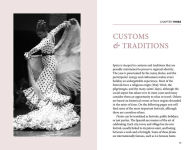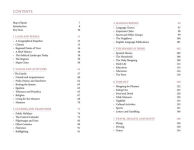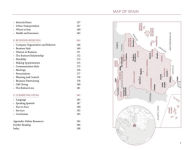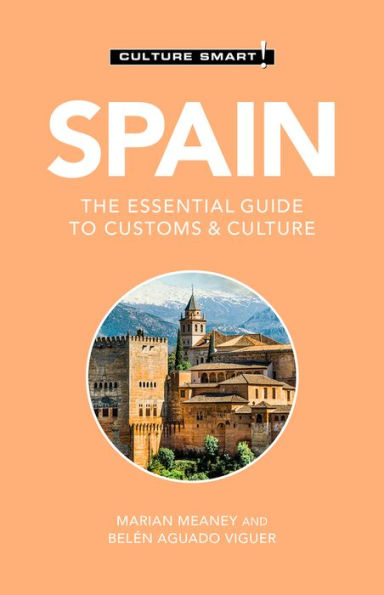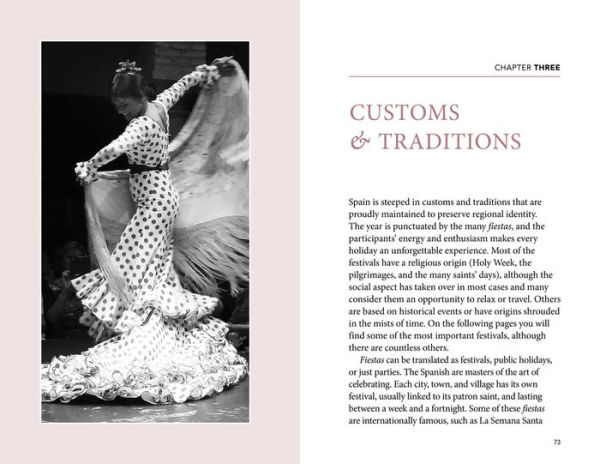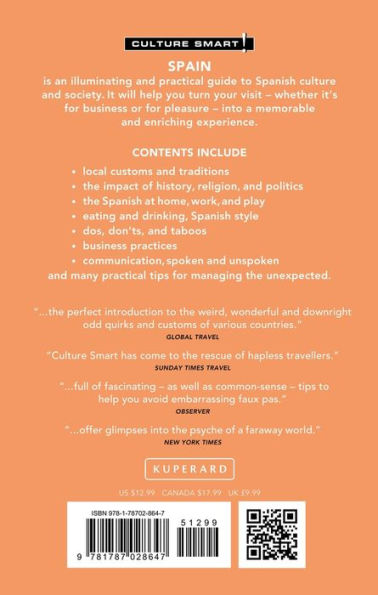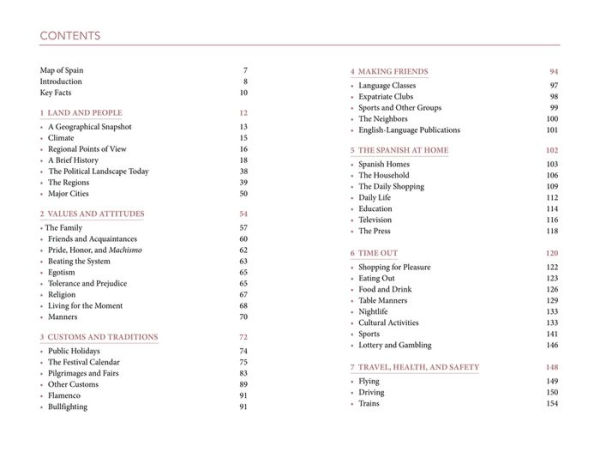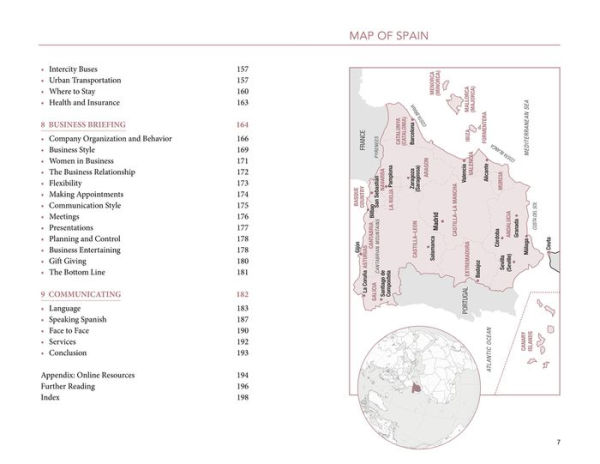Read an Excerpt
Spain
By Marian Meaney, Belén Aguado Viguer Bravo Ltd
Copyright © 2016 Kuperard
All rights reserved.
ISBN: 978-1-85733-838-6
CHAPTER 1
LAND & PEOPLE
A GEOGRAPHICAL SNAPSHOT
One of the largest countries in Europe, Spain is situated on the Iberian Peninsula, which it shares with two other countries: Portugal on the west and and the Principality of Andorra to the north. The Pyrenees run across the neck of the peninsula and form Spain's border with France. The large central plateau, the Meseta, is bordered and divided by several mountain ranges. Madrid, situated at the geographical center, at an average altitude of 2,100 feet (655 m), is the highest capital city in Europe.
Although Spain has rivers that are numbered among the longest in Europe (the Tajo, Ebro, and Duero), large areas of the country such as the Levante area in the southeast and most of the Canary Islands suffer from a scarcity of water. Linked to this problem is erosion, with millions of tons of topsoil being blown away each year. However, not all of Spain is dry or barren. The deep inlets of Galicia, the Cantabrian coast, and the snowy highlands of the Pyrenees are just a few examples of Spain's variety of landscape.
From a tourist's point of view, the coastline is immensely important. Spain has over two thousand beaches, many of them of great beauty. One out of six of the "Blue flags" given worldwide by the World Trade Organization to beaches of outstanding quality and high environmental standard is in Spain. They are grouped together under famous names corresponding to their position, such as the Costa Brava, Costa Dorada, Costa de Azahar, Costa Blanca, Mar Menor, Costa del Sol, Costa de la Luz, Rias Bajas and Rias Altas, Costa Cantábrica, Costa Canaria, and Costa Balear.
The total area of national territory is 195,350 square miles (505,955 sq. km), which includes the Canary and Balearic Islands and the two small enclaves of Ceuta and Melilla in Northern Africa. There is an incredible natural diversity to be enjoyed. As the British naturalists Chapman and Buck commented in their book Wild Spain (1893): "In no other land can there be found, within a similar area, such extremes of scene and climate."
CLIMATE
Although Spain lies in the temperate zone, its mountainous nature means that there are three differing climates: generally, wet, dry, and arid.
The wet climate (Oceanic and Mountainous), with more than 30 inches (800 mm) of precipitation per year occurs along the northwestern coast of Galicia and inland to Cataluña, and includes the northeastern coastal area that borders with France. These areas show only slight variations in temperature, with mild winters and cool summers. A cloudy sky and frequent rainfall are common, although less so during the summer months.
About 72 percent of the country has a dry climate (Mediterranean and Continental), receiving between 11 and 30 inches (300–800 mm) of precipitation per year. It is characteristic of the Levante area, the coast of Cataluña and most of the Balearic archipelago; the central plateau, and the valleys of the rivers Ebro, in the northeast, and Guadalquivir in Andalucía. Summer in these areas brings a blazing sun and an intense blue sky, with occasional, short-lived, local thunderstorms.
The arid climate, defined by less than 11 inches (300 mm) of rainfall per year is found in the some areas of the Levante, on the coast of Murcia (in the southeast) and in some interior areas.
The Canary Islands have a subtropical, Atlantic climate, which is generally dry except for the mountainous areas. They enjoy an almost constant temperature of just over 68°F (20°C), with only minor variations between seasons.
REGIONAL POINTS OF VIEW
Spanish people's loyalty to their country is especially evident when they travel or live abroad. Generally, they value their culture, gastronomy, climate, and the people enormously. Together, they represent what is meaningful in life for the average Spanish person. Therefore, you might be surprised to see a Spaniard passionately discussing and defending his own region against another. This is largely the result of the different perceptions the Spanish have about their history and the way it influenced their particular region.
There is, of course, no such thing as a typical Spaniard, but as in any other culture regional stereotypes abound: the entrepreneurial and greedy Catalans of the northeast, the hot-blooded and lively Andalusians of the south, and the good-natured and picaresque Castilians from the central Meseta. It is possible to distinguish people from different regions by paying attention to their accent, linguistic expressions, and their mannerisms. In the past, mountain ranges hindered communications, different climates influenced local character, and divisions arose that still have not been overcome. Long before the Catholic monarchs Ferdinand and Isabella united the kingdoms of Castile and Aragon by marriage and overthrew Muslim rule in 1492, there were various kingdoms within the peninsula, and Castilian dominance, for them, meant only a reduction in power. Spain was united in name only. The Golden Age did indeed bring great riches to the country, but not to the whole country, for most of the wealth was channeled to Castile or remained in the ports. Catalonia, which had been a major trading power, was at first not even allowed to trade with America.
The Basque Country and Catalonia fought hard for autonomy, which they finally received in 1978. Galicia, Andalucía, Asturias, and Cantabria followed, and today, there are nineteen autonomous regions that make up Spain. Catalonia sees itself as more modern and cosmopolitan than the rest of the country. Some citizens and politicians often use this perception to create a distance between the Catalans and the rest of Spain, going as far as promoting Catalonia as a separate state.
Differences in climate, traditions, and the character of the people in some regions, highlighted by the local language and dialects, may explain an initial feeling of disorientation that a Spaniard might experience when moving to a different region.
In general, however, the modern Spaniard is proud of his country. When Franco died in 1975 he left Spain weary of dictatorship and hungry for democracy and a place in the international community. In 1986 Spain became a member of both the European Union and NATO.
A BRIEF HISTORY
It is impossible to do justice in a few pages to Spain's rich and varied history. What follows is merely a brief synopsis.
Early Inhabitants
The Iberian Peninsula has been occupied for hundreds of thousands of years. Human bones from the Middle Pleistocene (at least 280,000 years old) have been found in the Cueva Mayor ("Main Cave" at Atapuerca, Burgos) and have helped to document human evolution in Europe.
The most advanced people living on the peninsula in classical antiquity were known as the Iberians. They lived along the Mediterranean and southern Atlantic coasts, and are now thought to be natives of the peninsula. The Celts lived mainly in the north and west except for the western Pyrenees, where the Basques lived, whose origin still remains uncertain.
The Greeks came to Spain, but had only two settlements, in the northeast. Many of the Greek artifacts found in Spain were actually passed on by Phoenician middlemen. In the ninth century BCE the Phoenicians founded their first settlement at Cadiz and established themselves along the southeastern Mediterranean coast. They traded oil and wine for silver, but also brought religious ideas, skilled metalworking, and literacy to the people. This period, sometimes known as the "orientalization" of prehistoric Spain, had an important impact on Iberian culture. The number of colonies diminished toward the end of the sixth century; those remaining were closer to Carthage, the most important of the Phoenicians' western Mediterranean settlements. However, by 218 BCE the Carthaginians, under Hannibal, had pushed far up the peninsula and brought upon themselves the wrath of the Roman Empire.
The Romans
The Romans landed in Ampurias, Gerona (Catalonia) in the second century BCE to destroy the power of the Carthaginians and make Spain part of their empire. It took them two hundred years to subdue the people. They constructed roads, irrigation systems, and engineering marvels. Some of the impressive examples — such as the aqueduct at Segovia, the bridge over the Tagus at Alcántara, or the amphitheater at Mérida — remain to this day. Spain's current language, religion, and laws stem from this period. Some of the upper classes in the towns and cities of Spain formed part of the elite of the Roman Empire. They included the philosopher and writer Seneca, the poet Martial, and several members of the Roman Senate, including Trajan and Hadrian, who later became emperors.
The Visigoths arrived in the fifth century CE, but the last Ibero-Roman strongholds did not fall until the seventh century CE.
The Arab Influence
In the year 711, Moors from northern Africa sailed across the mere eight miles (12.8 km) that separated them from Spain and, within a few years, had pushed the Visigoths right back to the Cantabrian Mountains in the north of the country. They remained in Spain for over eight hundred years, a time of tolerance when Muslims, Christians, and Jews lived together in peace. Medieval Spain was the only multiracial and multireligious country in Western Europe, and much of the development of Spanish civilization in religion, literature, art, and architecture during the later Middle Ages stemmed from this fact. Many of the beautiful buildings built by the Moors — such as Seville's Giralda Tower and Alcázar and the magical Alhambra of Granada — still enchant us today.
Different emirates rose and fell during this time. One example, the Caliphate of Córdoba, produced a brilliant civilization that lasted just over a hundred years before splitting into a number of rival princedoms. The court culture embraced fields as varied as historiography, calligraphy, poetry, music, botany, medicine, mathematics, astronomy, ivory carving, and metalwork. The Moors stayed in Spain until 1492, although by the second half of the thirteenth century their power had been limited to the stronghold of Granada.
The Reconquista
The divisions among the Moors paralleled those occurring in Christian Spain. The country was divided into different kingdoms, which were unwilling to unite forces until the second half of the fifteenth century.
Finally, Ferdinand of Aragon and Isabella of Castile united, at least on paper, their kingdoms. In practice during their reign each ruled his or her kingdom independently. The saying "Tanto monta, monta tanto, Isabel como Fernando" ("Both Isabella and Ferdinand amount to the same"), highlights the equal power of both according to their prenuptial agreement, which was very uncommon at that time. The marriage of the "Catholic Kings" led the Reconquista, or "Reconquest", the name given to the struggle to gain back the territory lost to the "nonbelievers."
Aided by the Inquisition they set out to free Spain from Arab domination and to achieve religious unification. Moors and Jews, who had actively contributed to the rise of an educated and commercial elite, and who held many administrative posts in Christian Spain, aroused jealousy and hatred in a population that saw itself as the defender of Christianity against the infidel.
Forcible attempts at conversion included confiscation of property, and torture, which often led to death. The Spanish Inquisition was founded in 1478 to root out heresy. After the last Moorish city, Granada, was taken, in 1492, all Jews who refused to convert to Christianity were expelled. Those who converted become subject to the Inquisition, whose role was to prevent backsliding among the "New Christians."
During the Protestant Reformation, fear of heresy led the Church to oppose new ideas, making Spain retreat slowly into intellectual conservatism.
By 1609 the last of the Moors had left, and Spain was bereft of both agricultural and administrative expertise. However, some influence remained. Many Christians from other countries had also studied with the Moors. One example was the School of Translators founded in the twelfth century at Toledo, where Jewish, Christian, and Muslim scholars had worked side by side. The resulting translations into Latin brought this treasury of human knowledge and philosophy not only to Spain, but also to Italy and France, planting the seeds of the Renaissance.
The Golden Age
The conquest of Granada allowed Castile to concentrate major resources and effort on overseas exploration instead of on domestic conflicts. The support that Christopher Columbus received from Isabella was indicative of this new policy. In 1492, during an expedition that was meant to establish a new route to Asia, Columbus made his great discovery of America — the New World. Spain and Portugal divided the spoils between them, and almost all of South America, Central America, North America, and the Philippines were added to the Spanish possessions. By exploiting the indigenous population, gold and silver, the primary objectives of the conquistadores, flowed through into Spain in fabulous quantities. In the sixteenth century, Spain was the most important power in the world, with a huge empire, fleets on every sea, and a brilliant cultural, artistic, and intellectual life.
When Charles I (elected Holy Roman Emperor in 1519 as Charles V) came to the throne, Spain was still divided into separate kingdoms and principalities. However, by the time he abdicated in favor of his son, Philip II, in 1556, Spain was on its way to becoming a centralized and absolute monarchy, although Catalonia, Navarre, Aragon, Valencia, and the Basque Country were still allowed a considerable degree of autonomy. This shift of power within Spain led to Catalonia, the most important trading region, not receiving any share in the new markets, and it was actually prohibited from dealing with the New World. By ridding itself of both the Jews and the Catalans, Spain deprived itself of its economically most active citizens and finally had to depend on German and Italian financiers.
Very little of the American treasure seems to have been invested in the economy. Most of it was used for display by the court, to pay for imports, for the armies abroad, and to satisfy foreign creditors. Thus Spain, with all the treasure of the New World at its command, remained a poor country.
During the sixteenth century the Church enlarged its already dominant position in Spanish life, and the Spanish Inquisition reached its greatest power. At the same time the Counter Reformation sought to reclaim Protestant Europe for the Church and to raise the spiritual tone of the Catholic countries. The Jesuit order, founded by St. Ignatius Loyola, an ex-soldier, was a major force. Its missionaries went all over the world and succeeded in converting millions to Catholicism. The life of a Jesuit was one of immense risk, and thousands of priests were persecuted or killed on their mission of conversion. However, in some nations, such as India and China, the Jesuits were welcomed as men of wisdom and science.
Education was of utmost importance to the Jesuits. In nearly every major city in Europe they established schools and colleges, and for a hundred and fifty years they were leaders in European education. (Through their loyalty to papal policies, the Jesuits were later drawn into the struggle between the papacy and the Bourbon monarchies and in the middle of the eighteenth century they were expelled from many countries including Spain. In 1814 they were reestablished once more.)
It was also a truly "Golden Age" for Spanish arts and literature. The novel reached its highest level with Cervantes' Don Quixote, which has been compared to Shakespeare's Hamlet and Homer's Iliad. Written to mock the popular novels of chivalry that glorified the ideals of courtesy, constancy, bravery, and loyalty, it was also considered part of the picaresque tradition (describing the adventures of a pícaro, a wandering rogue). There was a profusion of great poets, such as Garcilaso de la Vega, San Juan de la Cruz, and Luis de Góngora. The theater benefited from the many plays of Lope de Vega, Tirso de Molina, and Calderón de la Barca. Likewise, in the world of art Diego Velasquez, "El Greco" (Domenikos Theotokopoulos), Zurbarán, and Murillo were prominent artists of the time.
(Continues...)
Excerpted from Spain by Marian Meaney, Belén Aguado Viguer. Copyright © 2016 Kuperard. Excerpted by permission of Bravo Ltd.
All rights reserved. No part of this excerpt may be reproduced or reprinted without permission in writing from the publisher.
Excerpts are provided by Dial-A-Book Inc. solely for the personal use of visitors to this web site.




